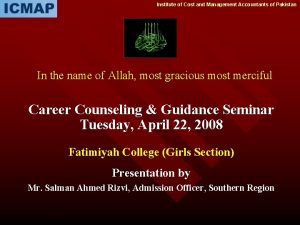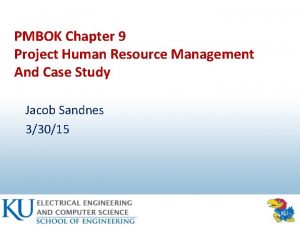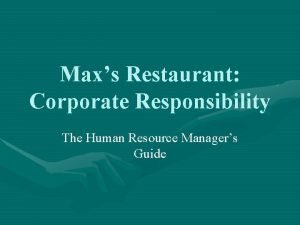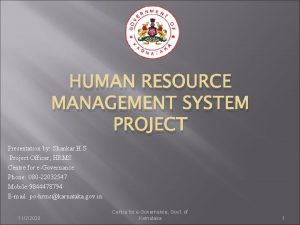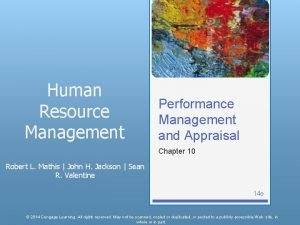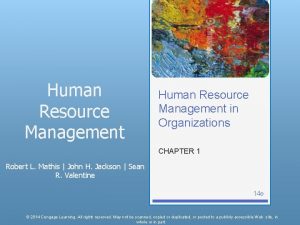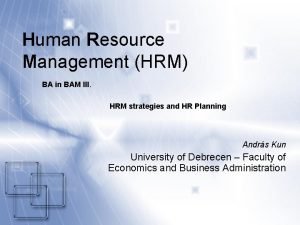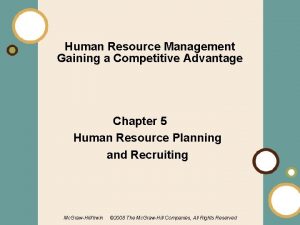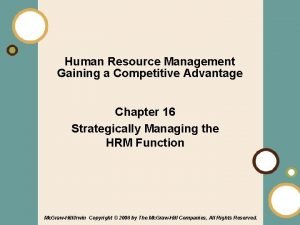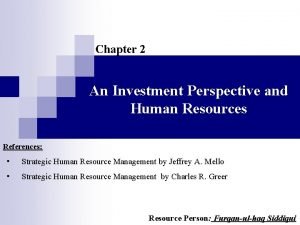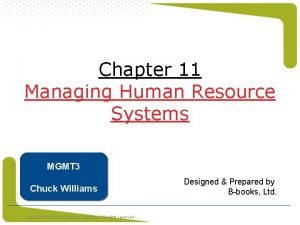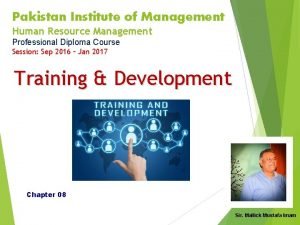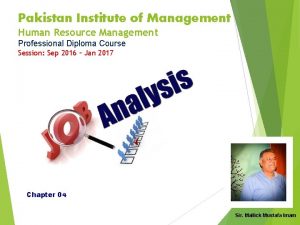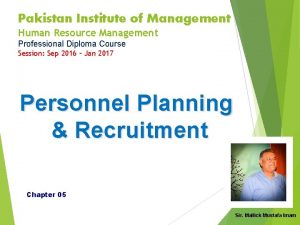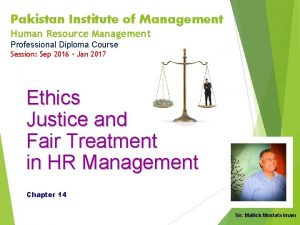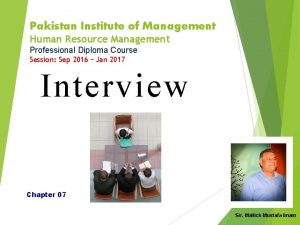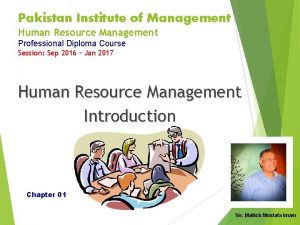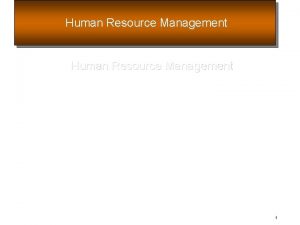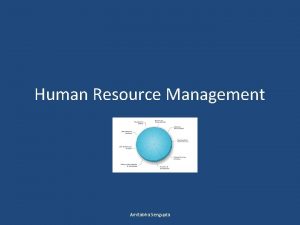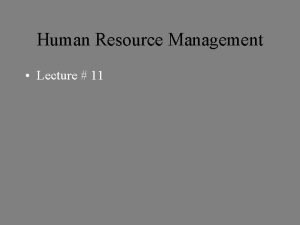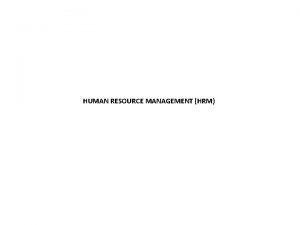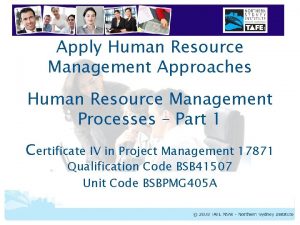Pakistan Institute of Management Human Resource Management Professional




























- Slides: 28

Pakistan Institute of Management Human Resource Management Professional Diploma Course Session: Sep 2016 – Jan 2017 Strategic Human Resource Management and the HR Scorecard Chapter 03 Sir. Mallick Mustafa Imam

FIGURE 3– 1 The Strategic Management Process

The Strategic Management Process Strategic Management Strategy The process of identifying and executing the organization’s mission by matching its capabilities with the demands of its environment. A chosen course of action. Strategic Plan How an organization intends to balance its internal strengths and weaknesses with its external opportunities and threats to maintain a competitive advantage over the long-term.

Business Vision and Mission Vision A general statement of an organization’s intended direction that evokes emotional feelings in organization members. Mission Spells out who the company is, what it does, and where it’s headed.

FIGURE 3– 2 A SWOT Chart © 2008 Prentice Hall, Inc. All rights reserved. 3– 5

FIGURE 3– 3 Strategies in a Nutshell Source: Arit Gadiesh and James Gilbert, “Frontline Action, ” Harvard Business Review, May 2001, p. 74. © 2008 Prentice Hall, Inc. All rights reserved. 3– 6

FIGURE 3– 4 Relationships Among Strategies in Multiple-Business Firms

Types of Strategies Corporate-Level Strategies Diversification Strategy Vertical Integration Strategy Consolidation Strategy Geographic Expansion Strategy

Types of Strategies (cont’d) Business-Level/ Competitive Strategies Cost Leadership Differentiation Focus/Niche

Strategic Human Resource Management The linking of HRM with strategic goals and objectives in order to improve business performance and develop organizational cultures that foster innovation and flexibility. Involves formulating and executing HR systems—HR policies and activities—that produce the employee competencies and behaviors that the company needs to achieve its strategic aims.

FIGURE 3– 6 Linking Company-Wide and HR Strategies Source: © Gary Dessler, Ph. D. , 2007. © 2008 Prentice Hall, Inc. All rights reserved. 3– 13

Human Resource Management’s Strategic Roles Strategic Planning Roles Strategy Execution Role Strategy Formulation Role

Creating the Strategic Human Resource Management System Components of a Strategic HRM System Human Resource Professionals Human Resource Policies and Practices Employee Behaviors and Competencies

d e r i u q e r s e e i m c o n r c e t e e e n b t p r o t a m P o R gic C H for trate S e h T

1. Leadership Understand the nature and styles of leadership, and display appropriate leadership characteristics in performance of professional responsibilities. Demonstrate leadership performance levels: Individual Team Unit or organization at multiple

2. Knowledge of the Business Understand corporate business (structure, vision and values, goals, strategies, financial and performance characteristics). Understand the unit’s business, including special knowledge of competitors, products, technology, and sources of competitive advantage. Understand internal and external customers. Understand the environment (external and internal) of corporation and individual business. Understand: Key business disciplines Nature, scope, and HR implications of business globalization Information technology as it affects competitiveness and business processes

3. HR Strategic Thinking Understand the strategic business planning process. Understand be able to apply a systematic HR planning process. Be able to select, design, and integrate HR systems or practices to build organizational mindset, capability, and competitive advantage for the business. Be able to develop and integrate business unit HR strategies within framework of corporate HR strategies.

4. Process Skills All HR professionals should be competent in key corporate processes and understand management processes critical to particular business units. Understand key process skills such as consulting, problem solving, evaluation / diagnosis, workshop design, and facilitation. Understand the basic principles, methodologies, and processes of organizational change and development. Facilitate and manage organizational change. Balance, integrate, and manage under conditions of uncertainty and paradox.

5. HR Technology All HR professionals should have a generalist perspective on HR systems and practices as they relate to achievement of business competitive advantage. Generalists are capable of designing, integrating, and implementing HR systems to build organizational capability and create business competitive advantage. Specialists are capable of designing / delivering leading-edge practices to meet competitive business needs. All HR professional are capable of measuring effectiveness of HR, systems and practices.

FIGURE 3– 8 Three Main Strategic Human Resource System Components Characteristics of HPWS • multi-skilled work teams • empowered front-line workers • extensive training • labor-management cooperation • commitment to quality • customer satisfaction Source: Adapted from Brian Becker et al. , The HR Scorecard: Linking People, Strategy, and Performance (Boston: Harvard Business School Press, 2001), p. 12. © 2008 Prentice Hall, Inc. All rights reserved. 3– 24

FIGURE 3– 9 Basic Model of How to Align HR Strategy and Actions with Business Strategy “ Source: Adapted from Garrett Walker and J. Randal Mac. Donald, “Designing and Implementing an HR Scorecard, ” Human Resources Management 40, no. 4 (2001), p. 370. © 2008 Prentice Hall, Inc. All rights reserved. 3– 25

THE HR SCORECARD The HR Scorecard is a concise measurement system. It shows the quantitative standards or metrics the firm uses to measure HR activities and to measure the employee behaviors resulting from these activities, and to measure the strategically relevant organizational outcomes of those employee behaviors. It highlights in a concise but comprehensive way, the causal link between the HR activities and the emergent employee behaviors and the resulting firm-wide strategic outcomes and performance. The most potent action HR managers can take to ensure their strategic contribution is to develop a measurement system that convincingly showcases HR’s impact on business performance.

The HR Scorecard To create an HR scorecard, the manager needs three types of information. 1. Know the company strategy 2. Understand the links between HR strategy, employee behaviors, the organizational outcomes and the organization’s performance. 3. Have metrics that can be used to measure all the activities and results involved, specifically the HR activities, the emergent employee behaviors, the strategically relevant organizational outcomes and the organizational performance.

The Seven Steps in the HR Scorecard Approach to Formulating HR Policies, Activities, and Strategies

Simple Value Chain for “The Hotel Paris”

HR Metrics Absence Rate [(Number of days absent in month) ÷ (Average number of employees during mo. ) × (number of workdays)] × 100 Cost per Hire (Advertising + Agency Fees + Employee Referrals + Travel cost of applicants and staff + Relocation costs + Recruiter pay and benefits) ÷ Number of Hires Health Care Costs per Employee Total cost of health care ÷ Total Employees HR Expense Factor HR expense ÷ Total operating expense Sources: Robert Grossman, “Measuring Up, ” HR Magazine, January 2000, pp. 29– 35; Peter V. Le Blanc, Paul Mulvey, and Jude T. Rich, “Improving the Return on Human Capital: New Metrics, ” Compensation and Benefits Review, January/February 2000, pp. 13– 20; Thomas E. Murphy and Sourushe Zandvakili, “Data and Metrics-Driven Approach to Human Resource Practices: Using Customers, Employees, and Financial Metrics, ” Human Resource Management 39, no. 1 (Spring 2000), pp. 93– 105; [HR Planning, Commerce Clearing House Incorporated, July 17, 1996; ] SHRM/EMA 2000 Cost Per Hire and Staffing Metrics Survey; www. shrm. org.

HR Metrics (cont’d) Human Capital ROI Revenue − (Operating Expense − [Compensation cost + Benefit cost]) ÷ (Compensation cost + Benefit cost) Human Capital Value Added Revenue − (Operating Expense − ([Compensation cost + Benefit Cost]) ÷ Total Number of FTE Revenue Factor Revenue ÷ Total Number of FTE Time to fill Total days elapsed to fill requisitions ÷ Number hired Sources: Robert Grossman, “Measuring Up, ” HR Magazine, January 2000, pp. 29– 35; Peter V. Le Blanc, Paul Mulvey, and Jude T. Rich, “Improving the Return on Human Capital: New Metrics, ” Compensation and Benefits Review, January/February 2000, pp. 13– 20; Thomas E. Murphy and Sourushe Zandvakili, “Data and Metrics-Driven Approach to Human Resource Practices: Using Customers, Employees, and Financial Metrics, ” Human Resource Management 39, no. 1 (Spring 2000), pp. 93– 105; [HR Planning, Commerce Clearing House Incorporated, July 17, 1996; ] SHRM/EMA 2000 Cost Per Hire and Staffing Metrics Survey; www. shrm. org.

HR Metrics (cont’d) Training Investment Factor Total training cost ÷ Headcount Turnover Costs Cost to terminate + Cost per hire + Vacancy Cost + Learning curve loss Turnover Rate [Number of separations during month ÷ Average number of employees during month] × 100 Workers’ Compensation Cost per Employee Total WC cost for Year ÷ Average number of employees Sources: Robert Grossman, “Measuring Up, ” HR Magazine, January 2000, pp. 29– 35; Peter V. Le Blanc, Paul Mulvey, and Jude T. Rich, “Improving the Return on Human Capital: New Metrics, ” Compensation and Benefits Review, January/February 2000, pp. 13– 20; Thomas E. Murphy and Sourushe Zandvakili, “Data and Metrics-Driven Approach to Human Resource Practices: Using Customers, Employees, and Financial Metrics, ” Human Resource Management 39, no. 1 (Spring 2000), pp. 93– 105; [HR Planning, Commerce Clearing House Incorporated, July 17, 1996; ] SHRM/EMA 2000 Cost Per Hire and Staffing Metrics Survey; www. shrm. org.
 Institute of cost and management accountants of pakistan
Institute of cost and management accountants of pakistan Time management in human resource management
Time management in human resource management Retail org chart
Retail org chart Function of personnel management
Function of personnel management Project human resource management pmbok ppt
Project human resource management pmbok ppt Project human resource management pmbok
Project human resource management pmbok Hrm importance
Hrm importance Restaurant human resources
Restaurant human resources Induction hr meaning
Induction hr meaning Chapter 2 human resource management
Chapter 2 human resource management Chapter 9 human resource management
Chapter 9 human resource management Human resource management system project
Human resource management system project Mbo performance appraisal method
Mbo performance appraisal method Current issues in human resource management
Current issues in human resource management Ba human resource management
Ba human resource management Acas discrimination
Acas discrimination Human resource management gaining a competitive advantage
Human resource management gaining a competitive advantage Human resource management gaining a competitive advantage
Human resource management gaining a competitive advantage Human resource management gaining a competitive advantage
Human resource management gaining a competitive advantage Human resource management question paper 2020
Human resource management question paper 2020 Performance appraisal in human resource management
Performance appraisal in human resource management Human resources department structure
Human resources department structure Hr proficiencies
Hr proficiencies Human resource management strategy and analysis
Human resource management strategy and analysis Investment perspective of human resource management
Investment perspective of human resource management Chapter 11 human resource management
Chapter 11 human resource management Chapter 1 introduction to human resource management
Chapter 1 introduction to human resource management Human resource management chapter 1
Human resource management chapter 1 Applied psychology in human resource management
Applied psychology in human resource management
